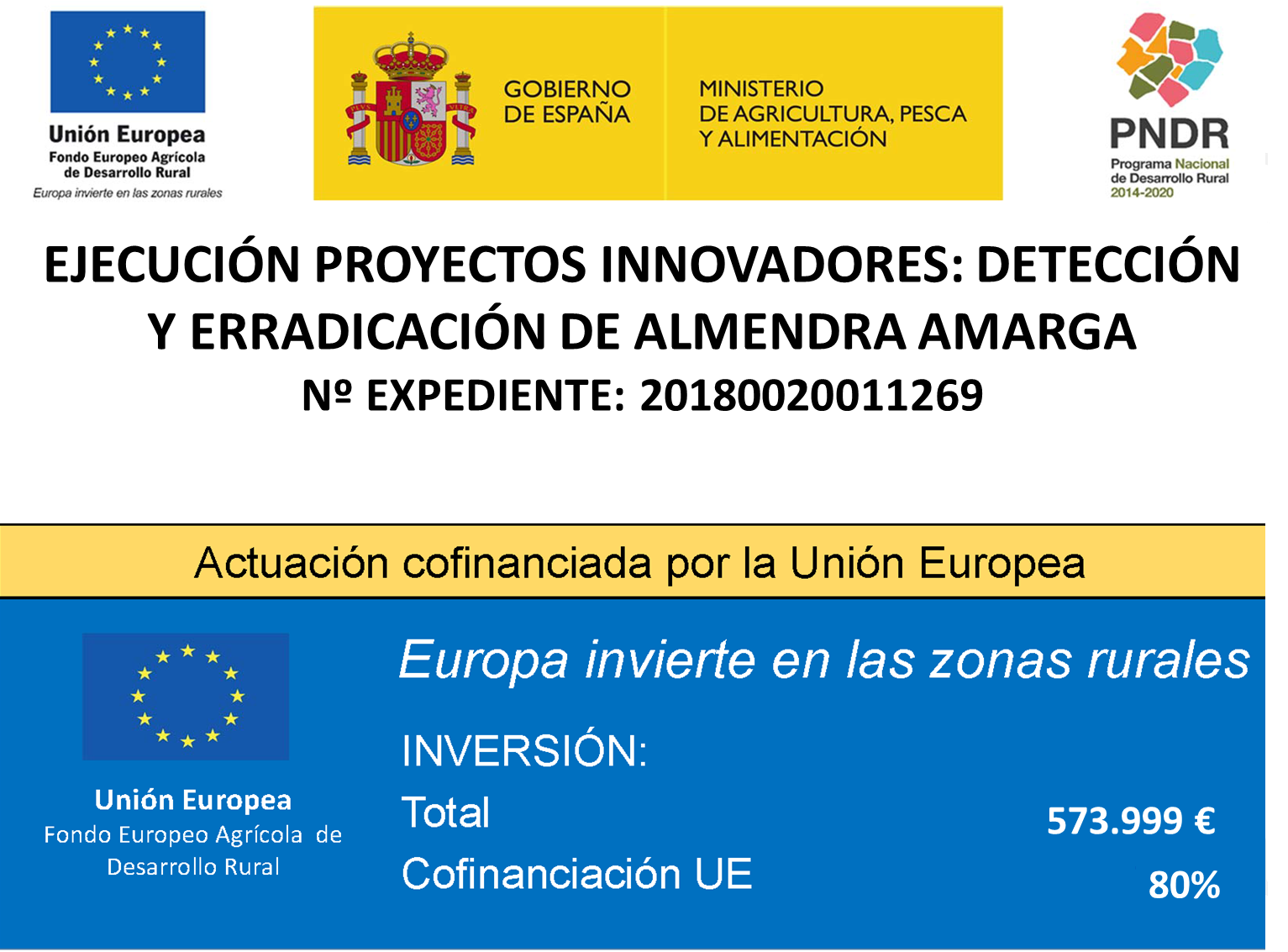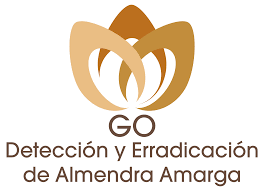Investigation and innovation
To always assure the maximum quality of the products we represent, the investment in R&D is the main pillar of all our associates, value that pursues the excellence in all its processes and products.
Therefore, SAB-Almendrave is nowadays involved, as a representative member, in the G.O.: Detection and eradication of the Bitter Almond, which develops a project to address the investigation and innovation for the development of systems which may be used, both in production and industrial scales, capable of detecting and eliminating bitter almonds in sweet almonds consignments, so offering the highest confidence to the consumer on the part of the marketing chain, being this one the main aim.

Being a project so relevant as necessary for our sector, it includes eight key entities within the Spanish almond sector: AEOFRUSE, SAB-Almendrave, ARBORETO SAT, BORGES AGRICULTURAL & INDUSTRIAL NUTS (BAIN), CRISOL DE FRUTOS SECOS SAT, DESCALMENDRA, MAÑÁN SOCIEDAD COOPERATIVA y UNIÓ NUTS, which will provide to this project, if possible, the best umbrella of protection to the Spanish almond sector. The Investigation and agro-Food Technology Institute (IRTA) is the outsourced member which will develop this project.
Task forceProject to eradicate the bitter almond
This project to eradicate the bitter almond has an operating budget of 573.999 euros and is framed within the aids to the European Innovation Partnership (EIP) Task Forces, whose objective is to increase the agricultural productivity and sustainability, throughout the National Rural Development Program (PNDR) 2014-2020, in its call of applications for 2018. The works are funded to 80 % by the European Agricultural Fund for Rural Development (EAFRD), and to 20 % by the Ministry of Agriculture, Fisheries and Food, under Royal Decree 169/2018, of March 23.
The agency responsible for the content of this project is the Task Force: The Detection and Eradication of the Bitter Almond, being the General Directorate for Rural Development, Innovation and Forestry Policy the authority in charge of managing the implementation of the corresponding EAFRD and National aid. Likewise, you can expand the information at the following link: http://ec.europa.eu/agriculture/index_es
Below we detail the project, information you may expand in: www.sinalmendraamarga.es
The agency responsible for the content of this project is the Task Force: The Detection and Eradication of the Bitter Almond, being the General Directorate for Rural Development, Innovation and Forestry Policy the authority in charge of managing the implementation of the corresponding EAFRD and National aid. Likewise, you can expand the information at the following link: http://ec.europa.eu/agriculture/index_es
Below we detail the project, information you may expand in: www.sinalmendraamarga.es
Objectives
General objective | Sectoral project for the development of systems that may be used at agronomic, productive and industrial scale to detect and eliminate the bitter almond. |
Specific objective 1 | Agronomic evaluation on the field of bitter trees and its geolocation for a possible elimination. Confirmation by means of Near infrared spectroscopy (NIRS) technology and use of innovative hydrocyanic kits. |
Specific objective 2 | Development of discriminant models with laboratory NIRS instruments, which will allow to separate by batch the bitter almond from the sweet one at the reception in almond cooperatives. |
Specific objective 3 | Validation of NIRS technology prototypes which will allow to detect and eliminate in the processing lines the bitter almond, in a one by one individual way, in the consignments of sweet almonds. |
Funding

Actions
So, the most important actions intended to be realized in each of the points are the following:
1. At the field level. Geolocation of the majority of candidate trees with a presence of bitter almonds in commercial farms. Once marked these trees, which will be identified for having an agronomic performance different to the rest, various fast tests for analysis will be made, with hydrocyanic detection kits, with portable NIR technology (fine-tuned during the first year) to check and confirm the presence of bitter almonds in those trees.
2. At the entrance in the reception centers level. Here we will operate on two levels. The first one is the use of laboratory analytical technology for the detection of the hydrocyanic acid derived from the degradation of the amygdalin present in the bitter almond, by means of innovative detection kits. And the second one will be the discrimination by batch, by means of NIR technology at the reception of the almond the farmer brings to the cooperative. A new discriminant model to separate both types of almonds (sweet vs bitter) will be developed.
3. At the processing lines level. Calibration and validation of NIR Hyperspectral on-line prototype, to eliminate one by one the bitter almonds with presence of amygdalin. Therefore, several milestones that will serve for the elimination of the bitter almond of our fields are expected to be achieved, such as the geolocation of the trees, the protocols for action for the analysis of the hydrocyanic kits, the NIR discriminant models at the field (leaf and fruit) and at the reception at the center or cooperative; and finally, to validate the NIR Hyperspectral prototypes which will allow to identify and eliminate the bitter almond at the processing lines on-line, one by one, validating at any time each one of the operations.
1. At the field level. Geolocation of the majority of candidate trees with a presence of bitter almonds in commercial farms. Once marked these trees, which will be identified for having an agronomic performance different to the rest, various fast tests for analysis will be made, with hydrocyanic detection kits, with portable NIR technology (fine-tuned during the first year) to check and confirm the presence of bitter almonds in those trees.
2. At the entrance in the reception centers level. Here we will operate on two levels. The first one is the use of laboratory analytical technology for the detection of the hydrocyanic acid derived from the degradation of the amygdalin present in the bitter almond, by means of innovative detection kits. And the second one will be the discrimination by batch, by means of NIR technology at the reception of the almond the farmer brings to the cooperative. A new discriminant model to separate both types of almonds (sweet vs bitter) will be developed.
3. At the processing lines level. Calibration and validation of NIR Hyperspectral on-line prototype, to eliminate one by one the bitter almonds with presence of amygdalin. Therefore, several milestones that will serve for the elimination of the bitter almond of our fields are expected to be achieved, such as the geolocation of the trees, the protocols for action for the analysis of the hydrocyanic kits, the NIR discriminant models at the field (leaf and fruit) and at the reception at the center or cooperative; and finally, to validate the NIR Hyperspectral prototypes which will allow to identify and eliminate the bitter almond at the processing lines on-line, one by one, validating at any time each one of the operations.
Expected results
The potential impacts and focus area this TF “Detection and eradication of the bitter almond”, led by ALMENDRAVE seeks to consolidate, is to give answers to the general objectives of the AEI-Agri, so as to work and influence over the Focus Area 2A and 3A.
Therefore, the ultimate impact for the sector is to increase the added value of the national almond sector (from the producer to the consumer), and that this will provide throughout the whole value and distribution chain a product of the best quality possible, thus giving the Spanish almond the chance to compete with the almond produced in other parts of the world. Therefore, the formation and launching of this TF will have an impact in all and each of the stages, from the farmer to the final consumer, going through cooperatives, hullers, processing industries (almond peeling and blanching), companies that use almond as raw material in the manufacture of their products (such as nougat manufacturers, chocolate companies, retail snacks companies) and the distribution companies of these products, that means markets, supermarkets and big surfaces.
The possibility to address the problem from three levels of action, will allow to demonstrate the effectiveness of each of the filters of action that will be pursued.
- Economic sustainability: The TF is designed from its beginning to comply with Focal Area 2A and 3A, increasing the economic performance of the holdings and improving the competiveness of the potential users of this innovation. Besides, if we are eliminating the bitter almond of our fields, we are increasing the quality of the whole food supply chain, this means from the farmer, to the final consumer, going through associations, producer organizations, cooperatives, industry and inter-branch organizations.
- Environmental sustainability: The environmental sustainability is reflected in the fact that in the three levels in which the TF will operate, this is, field, entrance at the cooperative and processing lines, it will be worked in a sustainable way and without polluting the environment. Therefore, the technology proposed to address the objectives and challenges never uses dangerous chemical agents, nor generates toxic waste. Besides, many of the members of the TF have Environmental Management Systems (ISO-14001), putting into practice an environmental protection comprehensive plan.
- Social sustainability: The TF, by being a multidisciplinary association of many actors of the entire value chain, will allow to shorten the distance between the scientific and research offer, provided by a referent as the IRTA, with the real needs of the agro-food primary sector, represented either by Producer Organizations, Agrofood Cooperatives and the private business.
Also, with this TF it’s intended the digitalization and the Big Data (with the use of leading technologies, as near infrared spectroscopy (NIRS), crucial today to fix the population in rural areas, thereby promoting the development of the same.
Therefore, the ultimate impact for the sector is to increase the added value of the national almond sector (from the producer to the consumer), and that this will provide throughout the whole value and distribution chain a product of the best quality possible, thus giving the Spanish almond the chance to compete with the almond produced in other parts of the world. Therefore, the formation and launching of this TF will have an impact in all and each of the stages, from the farmer to the final consumer, going through cooperatives, hullers, processing industries (almond peeling and blanching), companies that use almond as raw material in the manufacture of their products (such as nougat manufacturers, chocolate companies, retail snacks companies) and the distribution companies of these products, that means markets, supermarkets and big surfaces.
The possibility to address the problem from three levels of action, will allow to demonstrate the effectiveness of each of the filters of action that will be pursued.
- Economic sustainability: The TF is designed from its beginning to comply with Focal Area 2A and 3A, increasing the economic performance of the holdings and improving the competiveness of the potential users of this innovation. Besides, if we are eliminating the bitter almond of our fields, we are increasing the quality of the whole food supply chain, this means from the farmer, to the final consumer, going through associations, producer organizations, cooperatives, industry and inter-branch organizations.
- Environmental sustainability: The environmental sustainability is reflected in the fact that in the three levels in which the TF will operate, this is, field, entrance at the cooperative and processing lines, it will be worked in a sustainable way and without polluting the environment. Therefore, the technology proposed to address the objectives and challenges never uses dangerous chemical agents, nor generates toxic waste. Besides, many of the members of the TF have Environmental Management Systems (ISO-14001), putting into practice an environmental protection comprehensive plan.
- Social sustainability: The TF, by being a multidisciplinary association of many actors of the entire value chain, will allow to shorten the distance between the scientific and research offer, provided by a referent as the IRTA, with the real needs of the agro-food primary sector, represented either by Producer Organizations, Agrofood Cooperatives and the private business.
Also, with this TF it’s intended the digitalization and the Big Data (with the use of leading technologies, as near infrared spectroscopy (NIRS), crucial today to fix the population in rural areas, thereby promoting the development of the same.




